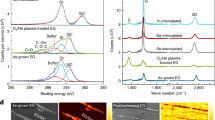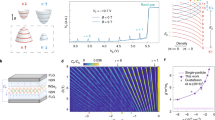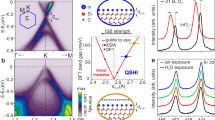Abstract
A decade of intense research on two-dimensional (2D) atomic crystals has revealed that their properties can differ greatly from those of the parent compound1,2. These differences are governed by changes in the band structure due to quantum confinement and are most profound if the underlying lattice symmetry changes3,4. Here we report a high-quality 2D electron gas in few-layer InSe encapsulated in hexagonal boron nitride under an inert atmosphere. Carrier mobilities are found to exceed 103 cm2 V−1 s−1 and 104 cm2 V−1 s−1 at room and liquid-helium temperatures, respectively, allowing the observation of the fully developed quantum Hall effect. The conduction electrons occupy a single 2D subband and have a small effective mass. Photoluminescence spectroscopy reveals that the bandgap increases by more than 0.5 eV with decreasing the thickness from bulk to bilayer InSe. The band-edge optical response vanishes in monolayer InSe, which is attributed to the monolayer's mirror-plane symmetry. Encapsulated 2D InSe expands the family of graphene-like semiconductors and, in terms of quality, is competitive with atomically thin dichalcogenides5,6,7 and black phosphorus8,9,10,11.
This is a preview of subscription content, access via your institution
Access options
Subscribe to this journal
Receive 12 print issues and online access
$259.00 per year
only $21.58 per issue
Buy this article
- Purchase on Springer Link
- Instant access to full article PDF
Prices may be subject to local taxes which are calculated during checkout




Similar content being viewed by others
References
Novoselov, K. S. et al. Two-dimensional atomic crystals. Proc. Natl Acad. Sci. USA 102, 10451–10453 (2005).
Geim, A. K. & Grigorieva, I. V. Van der Waals heterostructures. Nature 499, 419–425 (2013).
Castro Neto, A. H., Peres, N. M. R., Novoselov, K. S. & Geim, A. K. The electronic properties of graphene. Rev. Mod. Phys. 81, 109–162 (2009).
Mak, K. F., Lee, C., Hone, J., Shan, J. & Heinz, T. F. Atomically thin MoS2: a new direct-gap semiconductor. Phys. Rev. Lett. 105, 2–5 (2010).
Cui, X. et al. Multi-terminal transport measurements of MoS2 using a van der Waals heterostructure device platform. Nat. Nanotech. 10, 534–540 (2015).
Fallahazad, B. et al. Shubnikov–de Haas oscillations of high-mobility holes in monolayer and bilayer WSe2: Landau level degeneracy, effective mass, and negative compressibility. Phys. Rev. Lett. 116, 086601 (2016).
Xu, S. et al. Universal low-temperature ohmic contacts for quantum transport in transition metal dichalcogenides. 2D Mater. 3, 021007 (2016).
Tayari, V. et al. Two-dimensional magnetotransport in a black phosphorus naked quantum well. Nat. Commun. 6, 7702 (2015).
Li, L. et al. Quantum oscillations in a two-dimensional electron gas in black phosphorus thin films. Nat. Nanotech. 10, 608–613 (2015).
Gillgren, N. et al. Gate tunable quantum oscillations in air-stable and high mobility few-layer phosphorene heterostructures. 2D Mater. 2, 011001 (2014).
Li, L. et al. Quantum Hall effect in black phosphorus two-dimensional electron system. Nat. Nanotech. 11, 6–10 (2016).
Kuroda, N. & Nishina, Y. Resonance Raman scattering study on exciton and polaron anisotropies in InSe. Solid State Commun. 34, 481–484 (1980).
Kress-Rogers, E., Nicholas, R. J., Portal, J. C. & Chevy, A. Cyclotron resonance studies on bulk and two-dimensional conduction electrons in InSe. Solid State Commun. 44, 379–383 (1982).
Segura, A., Pomer, F., Cantarero, A., Krause, W. & Chevy, A. Electron scattering mechanisms in n-type indium selenide. Phys. Rev. B 29, 5708–5717 (1984).
Camassel, J., Merle, P., Mathieu, H. & Chevy, A. Excitonic absorption edge of indium selenide. Phys. Rev. B 17, 4718–4725 (1978).
Lei, S. et al. Evolution of the electronic band structure and efficient photo-detection in atomic layers of InSe. ACS Nano 8, 1263–1272 (2014).
Mudd, G. W. et al. Tuning the bandgap of exfoliated InSe nanosheets by quantum confinement. Adv. Mater. 25, 5714–5718 (2013).
Brotons-Gisbert, M. et al. Nanotexturing to enhance photoluminescent response of atomically thin indium selenide with highly tunable band gap. Nano Lett. 16, 3221–3229 (2016).
Zolyomi, V., Drummond, N. D. & Fal'ko, V. I. Electrons and phonons in single layers of hexagonal indium chalcogenides from ab initio calculations. Phys. Rev. B 89, 1–8 (2014).
Feng, W. et al. Ultrahigh photo-responsivity and detectivity in multilayer InSe nanosheets phototransistors with broadband response. J. Mater. Chem. C 3, 7022–7028 (2015).
Mudd, G. W. et al. High broad-band photoresponsivity of mechanically formed InSe–graphene van der Waals heterostructures. Adv. Mater. 27, 3760–3766 (2015).
Tamalampudi, S. R. et al. High performance and bendable few-layered InSe photodetectors with broad spectral response. Nano Lett. 14, 2800–2806 (2014).
Feng, W., Zheng, W., Cao, W. & Hu, P. Back gated multilayer InSe transistors with enhanced carrier mobilities via the suppression of carrier scattering from a dielectric interface. Adv. Mater. 26, 6587–6593 (2014).
Sucharitakul, S. et al. Intrinsic electron mobility exceeding 103 cm2/Vs in multilayer InSe FETs. Nano Lett. 15, 3815–3819 (2015).
Kress-Rogers, E. et al. The electric sub-band structure of electron accumulation layers in InSe from Shubnikov–de Haas oscillations and inter-sub-band resonance. J. Phys. C 16, 4285–4295 (2000).
Wang, L. et al. One-dimensional electrical contact to a two-dimensional material. Science 342, 614–617 (2013).
Kretinin, A. V. et al. Electronic properties of graphene encapsulated with different two-dimensional atomic crystals. Nano Lett. 14, 3270–3276 (2014).
Cao, Y. et al. Quality heterostructures from two-dimensional crystals unstable in air by their assembly in inert atmosphere. Nano Lett. 15, 4914–4921 (2015).
Sun, C . et al. Ab initio study of carrier mobility of few-layer InSe. Appl. Phys. Express 9, 035203 (2016).
Castellanos-Gomez, A. Why all the fuss about 2D semiconductors? Nat. Photon. 10, 202–204 (2016).
Favron, A. et al. Photooxidation and quantum confinement effects in exfoliated black phosphorus. Nat. Mater. 14, 826–832 (2015).
Acknowledgements
This work was supported by the European Research Council, the Graphene Flagship, the Engineering and Physical Sciences Research Council (EPSRC, UK) and The Royal Society. D.A.B. and I.V.G. acknowledge support from the Marie Curie programme SPINOGRAPH (Spintronics in Graphene). A.M. acknowledges support of the EPSRC Early Career Fellowship EP/N007131/1. S.V.M. was supported by the NUST MISiS (grant K1-2015-046) and the Russian Foundation for Basic Research (RFBR15-02-01221 and RFBR14-02-00792). V.F. acknowledges support from the ERC Synergy Grant Hetero2D, the EPSRC grant EP/N010345/1 and the Lloyd Register Foundation Nanotechnology grant, and V.Z. from the European Graphene Flagship Project. Measurements in high magnetic field were supported by the High Field Magnet Laboratory–Radboud University/Foundation for Fundamental Research on Matter, member of the European Magnetic Field Laboratory, and by the EPSRC via its membership to the EMFL (grant EP/N01085X/1). We thank M. Mohammed for assisting with UV PL measurements.
Author information
Authors and Affiliations
Contributions
D.A.B., G.L.Y., R.K.K., A.M. and S.V.M. performed transport measurements and A.V.T. carried out optical studies. D.A.B. and A.V.T. analysed experimental data with help from A.K.G. and V.I.F. Y.C. fabricated devices and co-supervised the project with help from R.V.G. V.Z. and V.I.F. provided theory support. Z.R.K., Z.D.K. and A.P. provided bulk InSe crystals. D.A.B., V.I.F. and A.K.G. wrote the manuscript. All authors contributed to discussions.
Corresponding authors
Ethics declarations
Competing interests
The authors declare no competing financial interests.
Supplementary information
Supplementary information
Supplementary information (PDF 1415 kb)
Rights and permissions
About this article
Cite this article
Bandurin, D., Tyurnina, A., Yu, G. et al. High electron mobility, quantum Hall effect and anomalous optical response in atomically thin InSe. Nature Nanotech 12, 223–227 (2017). https://doi.org/10.1038/nnano.2016.242
Received:
Accepted:
Published:
Issue Date:
DOI: https://doi.org/10.1038/nnano.2016.242
This article is cited by
-
Monolayer indium selenide: an indirect bandgap material exhibits efficient brightening of dark excitons
npj 2D Materials and Applications (2024)
-
Structural and surface characterizations of 2D β-In2Se3/3D β-Ga2O3 heterostructures grown on c-Sapphire substrates by molecular beam epitaxy
Scientific Reports (2024)
-
Electronic Structure and Photocatalytic Water Splitting Application of a New Type II g-ZnO/Ga2SSe van der waals Heterostructure
Catalysis Letters (2024)
-
Self-powered and broadband opto-sensor with bionic visual adaptation function based on multilayer γ-InSe flakes
Light: Science & Applications (2023)
-
Electrical detection of the flat-band dispersion in van der Waals field-effect structures
Nature Nanotechnology (2023)



